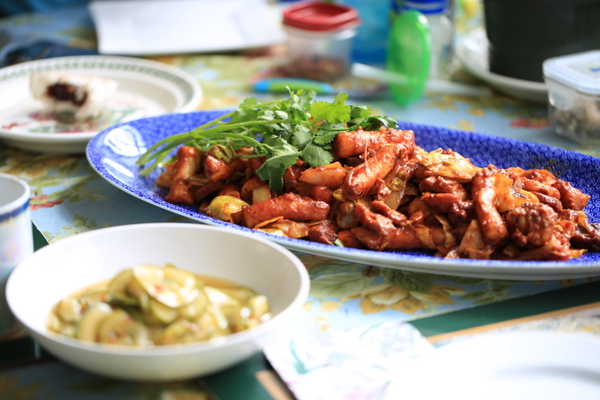Most of us have at one point contemplated on death and what happens once we die. How will I die? Where will my remains be buried? Will I go to Heaven? Or be reincarnated? If so, as what?
My father has often talked about such questions since I was little. He believes that living is, in a way, a long preparation for death. I think he has a point. Now in his early 70s, my father has taken care not only to arrange for his own burial site, but those of his family and descendents across several generations. In fact, he has built a family cemetery.
My father bought a fairly large parcel of land to build a family tomb. It's an indoor vault where the cremated remains of the deceased‐‐over 200‐‐will be stored. This is the largest private tomb in Jeju. Dad took my husband and me to see the vault. Outside the vault, my father lays out fruits and wine for a simple ancestral rite.
.jpg)
It was a hot day, but inside the vault it was much cooler, perhaps as it is inside a pyramid. The vault is made of marble and allows for ventilation and sunlight.
Inside the vault there are over 200 drawers. Each is designated for a particular family member, from my father's ancestors to posterity. On the front surface of each drawer is attached an individual tablet.
-2.jpg)
-4.jpg)
This family cemetery is for the males of the Yang family and their wives. Women who marry are considered no longer a Yang but a member of their husband's family. Therefore, I am a "Lee" instead of a "Yang," and am not eligible to be buried here.
However, my dad said if I wished to be buried here‐‐with my husband's consent‐‐that I would take drawer number 51 and my hubby number 52.
-6.jpg)
Visiting the family cemetery my father has built, I come to think that it would be nice to be buried in Korea, the country of my birth and upbringing. If my husband and I were buried here, that would give our son, Russell, who was born in the U.S. and will likely live in the U.S., an extra incentive to visit Korea‐‐I hope.Korea is overpopulated for its territorial size; hence, burial land is in short supply. By law, most public cemeteries‐‐where the majority of Koreans are buried‐‐can keep the remains for only 50 years. Thereafter, it is up to the descendents to transfer the remains to another private site.
-5.jpg)
Otherwise, they are moved and destroyed. My dad built a permanent family cemetery in consideration of these realities on land that by law cannot be converted into something else. So as long as the Korean state exists, so will this family cemetery. Our descendents will be able to participate together in ancestral rites at this site. Ancestral rites are essential to the Confucian civilization and my family, including my two brothers, are strict adherents to this practice.
My husband visited this family cemetery more as a tourist, but is quite moved by the surroundings and is quick to help my dad set up the impromptu offerings to his ancestors. My dad also mentioned that he intends to build a playground off on a corner for children to play in.
Returning home we picked up my mother and went to a popular naengmyun (buckwheat noodles in cold beef broth) restaurant. Naengmyun is a favorite food in Korea, especially in hot weather. This is the oldest naengmyun restaurant in Jeju. Slurping in the cold noodles, it occurs to me that noodles are a traditional symbol of longevity.
















































